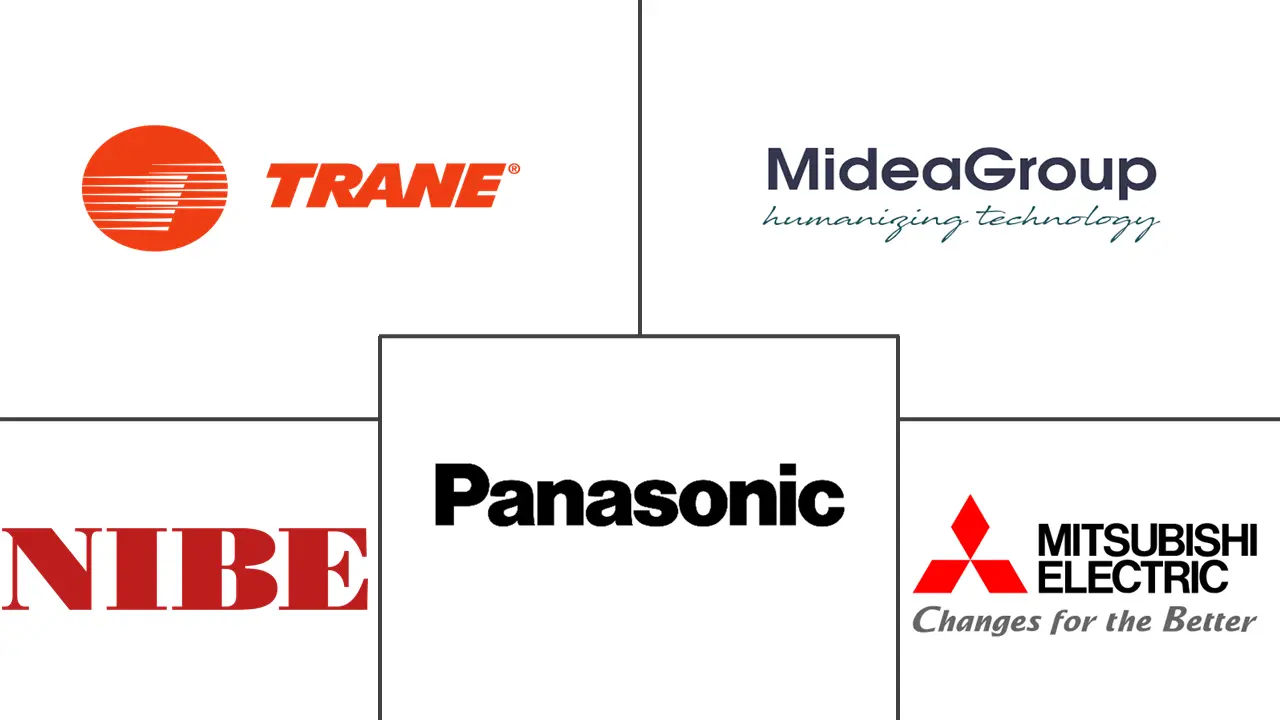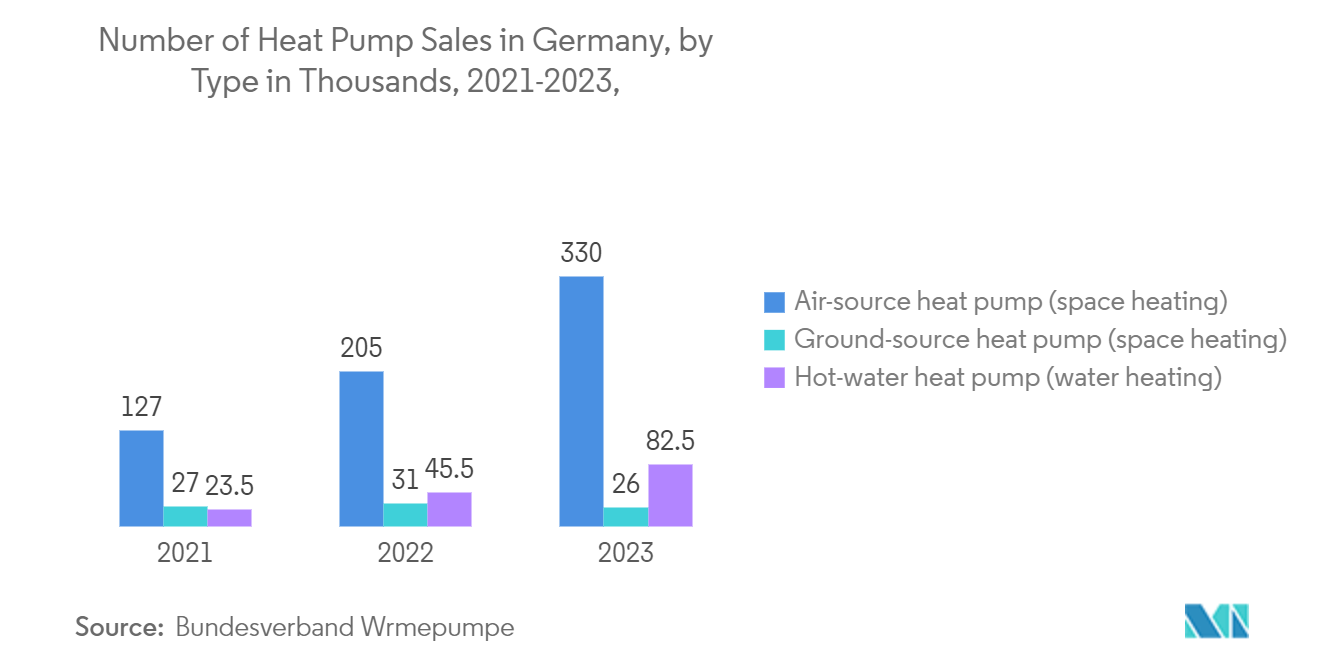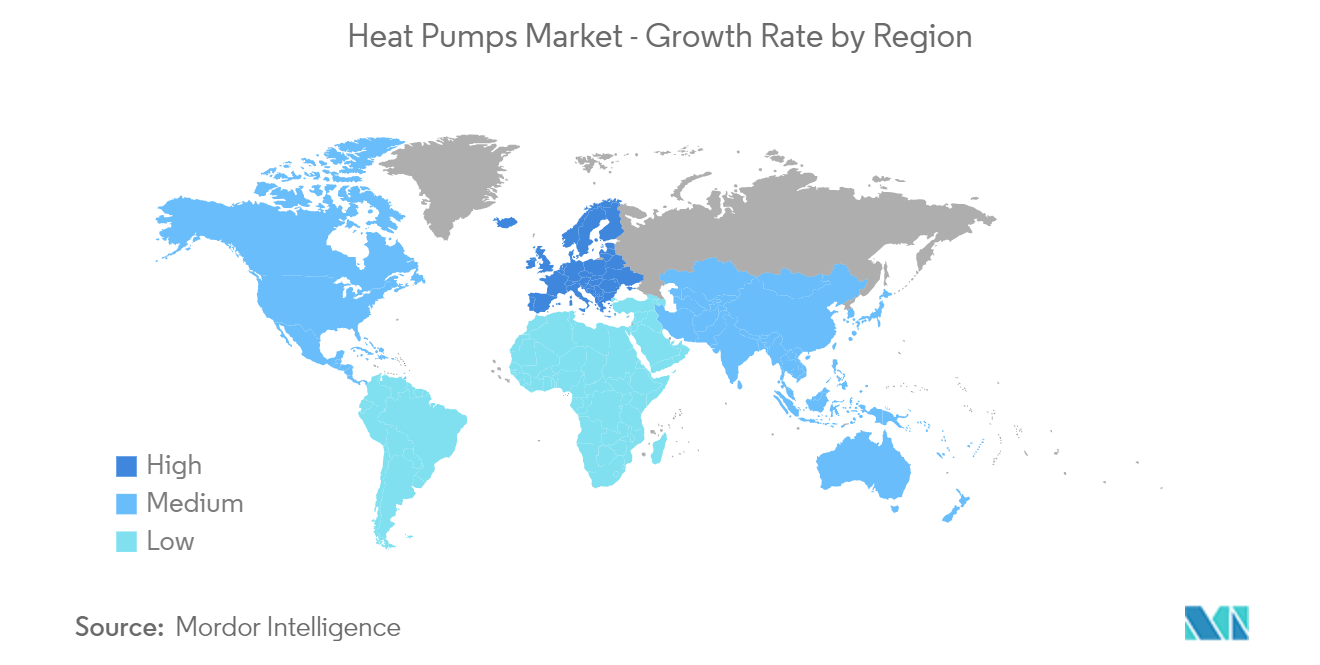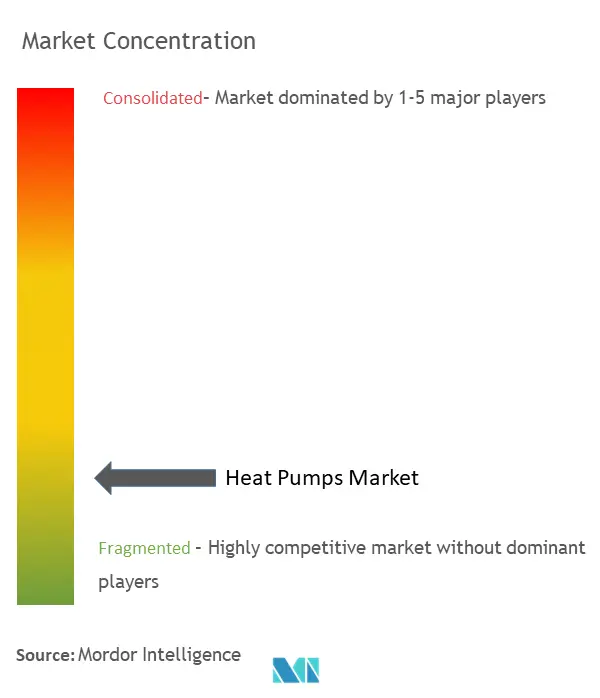Heat Pump Market Size

| Study Period | 2019 - 2029 |
| Market Size (2024) | USD 68.71 Billion |
| Market Size (2029) | USD 109.66 Billion |
| CAGR (2024 - 2029) | 9.80 % |
| Fastest Growing Market | Europe |
| Largest Market | Asia Pacific |
Major Players
*Disclaimer: Major Players sorted in no particular order |
Heat Pump Market Analysis
The Global Heat Pumps Market size is estimated at USD 68.71 billion in 2024, and is expected to reach USD 109.66 billion by 2029, growing at a CAGR of 9.80% during the forecast period (2024-2029).
The heat pump works on the principle of mechanical-compression cycle refrigeration that can even be reversed to heat or cool the desired space of a facility. Hence, the market studied is growing for cooling applications and space heating.
- Heat pumps are strategically placed to benefit from the drive to environmental sustainability. Furthermore, the European Union's strategy of sector integration suggests that 65% of all commercial buildings will be heated by electricity in 2030. The data indicate that heat pump sales are only expected to grow with buildings depending on them for heating and cooling.
- Furthermore, The growing demand for energy-efficient devices has been driving the deployment of technology, such as heat pumps, to provide end users with significant potential to contribute to renewable energy and climate targets across various regions worldwide.
- Moreover, The growing need to curb dependence on fossil fuels and look for an energy-efficient alternative to furnaces and air conditioners is expected to boost the demand for heat pumps over the forecast period. As heat pumps transfer heat rather than generate heat, they can offer equivalent space conditioning at as little as one-quarter of the operating costs of conventional heating or cooling appliances.
- Heating a few areas of the facility may save money on material costs for the air handler unit (AHU). However, these factors may affect the overall installation costs if heat pumps are installed as the main heating and cooling system.
- While it is realistic to expect slow growth or even a decline in heat pump sales owing to the COVID-19 pandemic, government policies and consumer demand are expected to drive the sales of heat pumps.
Heat Pump Market Trends
Residential Heat Pumps are Expected to Witness Significant Growth
- The regulations implemented in different regions aimed at promoting nearly zero energy buildings are directing residential buildings to improve energy performance through efficient energy sources, such as heat pumps. Heat pumps are often used as heat sources in single-family and terraced houses. Heat pumps are also increasingly used in apartment buildings.
- Further, the 2022 Building Energy Efficiency Standards (Energy Code) adopted by the California Energy Commission (CEC), which goes into effect January 1, 2023, introduced some new requirements for buildings in California, United States. According to the 2022 Energy Code, new single-family homes must have electric heat pumps for water and air. Electric heat pumps for space heating are also needed in all new multi-family residences.
- Vendors are also focusing on residential decarbonizing to decrease CO2 emissions. For instance, in recent years, Daikin announced a four-step plan to transform residential heating and cooling. According to the company, the European building stock is responsible for approximately 36 % of all CO2 emissions in the European Union. Therefore, heat pumps are being deployed in new residential constructions, thus, driving the need for heat pumps in the region.
- Residential construction has seen a considerable boost in many markets despite the impact of COVID-19, which also supports market growth. For instance, the German construction sector was expected to bring in sales of EUR 151 billion in 2022, up 5.5% from 2021, according to figures from the country's two leading construction associations, ZDB and HDB. The growth projection was anticipated to be led by the strong performance of the country's residential construction sector, which has remained resilient throughout the pandemic.
- Further, in April 2022, Daikin announced its support for the REPowerEU, which has set a goal to boost the rollout of heat pumps from 10 million units in 2027 to 30 million units in 2030. This is further associated with residential decarbonization as the movement can help the European Union achieve the residential sector's decarbonization goals by 2050.
- As stated by Bundesverband Wärmepumpe, the majority of heat pumps purchased in Germany in 2023 were aerothermal, meaning they draw energy from the external air. Moreover, the quantity of heat pumps being utilized for heating household water is rapidly rising.

Asia Pacific Expected to Dominate the Market
- China is one of the significant markets for heat pumps, owing to the government's policies to support more energy-efficient infrastructure in the country, thereby augmenting the market growth. China's vast geographic area is officially divided into five primary climate zones with different thermal design requirements. Heating solutions for these regions can be tailor-made to meet the huge market opportunities.
- In Japan, heat pumps are well-known products in private and commercial settings. Various types of industries have also embraced them. This development began several decades ago and has been further pushed by energy conservation measures. These were formulated by the Agency for Natural Resources and Energy, stipulating energy conservation of 50.3 million m3 crude oil equivalent between 2013 and 2030. Such instances are likely to boost the demand for heat pumps in the country.
- Applications of heat pumps in hotels, malls, theatres, etc., are gradually gaining traction in India. Moreover, a tremendous amount of solar energy is available in the country. According to the Ministry of New and Renewable Energy, solar power installed capacity reached around 61.97 GW as of 30th November 2022. The country stood 4th in solar PV deployment across the globe in the previous year. The system combination of solar thermal collectors and heat pumps can be an attractive option for increasing renewable energy usage worldwide for heating and domestic hot water preparation.
- In South Korea, government initiatives concerning energy-efficient solutions are driving the market growth. For instance, a study carried out by Korea's Ministry of the Environment on the Hyundai Kona Electric, and Kia Niro EV found that the heat pump significantly reduced battery consumption in cold conditions.
- In Australia, the Green Building Council of Australia (GBCA) launched the Green Star certification in 2003. Additionally, the Australian Government is focused on a 26-28% reduction in greenhouse gas emissions from 2005 levels by 2030. Such instances demonstrate a significant market growth opportunity over the forecast period.
- The countries considered under the rest of Asia-Pacific include Indonesia, Singapore, and Thailand. Indonesia is one of the leading geothermal energy powers in the world and has set ambitions to grow the sector further as the country embraces renewable energy sources. For instance, During the 8th Indonesia International Geothermal Convention & Exhibition (IIGCE) 2022, the Indonesian government announced that, through the General Plan for the Provision of Electricity, it had set a geothermal development target of 3.3 GW installed capacity by 2030. Such initiatives are likely to create a positive outlook for the studied market.

Heat Pump Industry Overview
The competitive rivalry in the global heat pumps market is high owing to the presence of some major players such as Trane Inc., Midea Group, Panasonic Corporation, Mitsubishi Electric Corporation, and Daikin Industries Ltd, amongst others. Their ability to continually innovate their offerings has enabled them to gain a competitive advantage over other players in the market. These players have expanded their market footprint through R&D activities, mergers & acquisitions.
- November 2022 - TRANE announced that it would reduce the carbon impact of its endurable HVAC solutions by buying low-carbon steel from major supplier Nucor Corporation Econiq, with an additional allotment from US Steel verdeX. The steel will be utilized in US manufacturing processes to build Trane high-efficiency heat pumps and air conditioners for homes and thermal management systems for commercial buildings such as schools and data centers.
- November 2022 - Mitsubishi launched a cascaded air source heat pump that can produce between 7.8 kW and 640 kW of heat. The heat pump can generate hot water at a temperature of up to 70 C without boost heaters. Mitsubishi Electric released the air source heat pump for commercial applications, including schools and hospitals.
Heat Pump Market Leaders
-
Trane Inc. (Trane Technologies PLC)
-
Midea Group
-
NIBE Group
-
Panasonic Corporation
-
Mitsubishi Electric Corporation
*Disclaimer: Major Players sorted in no particular order

Heat Pump Market News
- January 2023 - Mitsubishi Electric US and Mitsubishi Electric Trane HVAC US LLC showcased their innovative heating technologies at the Consumer Electronics Show (CES) 2023, which took place in Las Vegas, United States. Specifically, the companies introduced their variable capacity heat pump technology, which is all-weather and energy efficient.
- October 2022 - Midea Group started constructing a new base for producing, researching, and developing heat pumps in Feltre, in northern Italy, to help facilitate its international market expansion. The new base, with an investment of EUR 60 million (USD 58.75 million), is located inside a production area of Italy's Clivet, a European company involved in the design, production, and distribution of systems for cooling, heating, air ventilation and air purification for residential, commercial and industrial markets.
Heat Pump Market Report - Table of Contents
1. INTRODUCTION
- 1.1 Study Assumptions and Market Definition
- 1.2 Scope of the Study
2. RESEARCH METHODOLOGY
3. EXECUTIVE SUMMARY
4. MARKET INSIGHTS
- 4.1 Market Overview
- 4.2 Industry Value Chain Analysis
-
4.3 Industry Attractiveness - Porter's Five Forces Analysis
- 4.3.1 Bargaining Power of Suppliers
- 4.3.2 Bargaining Power of Buyers
- 4.3.3 Threat of New Entrants
- 4.3.4 Threat of Substitute Products
- 4.3.5 Degree of Competition
- 4.4 Impact of COVID-19 on the Market
5. MARKET DYNAMICS
-
5.1 Market Drivers
- 5.1.1 Increasing Demand for Energy Efficient Solutions
- 5.1.2 Increasing Government Initiatives to Curb Carbon Emission
-
5.2 Market Restraints
- 5.2.1 High Installation Cost of Heat Pumps
6. MARKET SEGMENTATION
-
6.1 By Type
- 6.1.1 Air-Source
- 6.1.2 Water-Source
- 6.1.3 Geothermal (Ground) Source
-
6.2 By End-User Vertical
- 6.2.1 Industrial
- 6.2.2 Commercial
- 6.2.3 Institutional
- 6.2.4 Residential
-
6.3 By Geography***
- 6.3.1 North America
- 6.3.1.1 United States
- 6.3.1.2 Canada
- 6.3.2 Europe
- 6.3.2.1 Spain
- 6.3.2.2 France
- 6.3.2.3 Italy
- 6.3.2.4 Germany
- 6.3.2.5 Netherlands
- 6.3.3 Asia
- 6.3.3.1 China
- 6.3.3.2 Japan
- 6.3.3.3 India
- 6.3.3.4 South Korea
- 6.3.4 Australia and New Zealand
- 6.3.5 Latin America
- 6.3.6 Middle East and Africa
7. COMPETITIVE LANDSCAPE
-
7.1 Company Profiles*
- 7.1.1 Trane Inc. (Trane Technologies)
- 7.1.2 Midea Group
- 7.1.3 NIBE Group
- 7.1.4 Panasonic Corporation
- 7.1.5 Mitsubishi Electric Corporation
- 7.1.6 Daikin Industries Ltd
- 7.1.7 Stiebel Eltron GmbH & Co. KG (De)
- 7.1.8 Glen Dimplex Group
- 7.1.9 Viessmann Werke GmbH & Co. KG
- 7.1.10 Flamingo Heat Pumps (Flamingo Chillers)
- 7.1.11 WOLF GMBH (ARISTON GROUP)
- 7.1.12 Efficiency Maine
8. INVESTMENT ANALYSIS
9. FUTURE OF THE MARKET
** Subject To AvailablityHeat Pump Industry Segmentation
A heat pump is an electrically-driven device that extracts heat from a source (a low-temperature place) and delivers it to a sink (a higher-temperature place). In other words, a heat pump is a device that uses a small amount of energy to move heat from one location to another. The working of heat pumps can also be reversed to cool a building.
The Heat Pumps Market is segmented by type (air source, water source, geothermal (ground) source), by end-user vertical (industrial, commercial, institutional, residential), and geography (North America [United States, Canada], Europe [Spain, France, Italy, Germany, Netherlands], Asia Pacific [China, Japan, India, South Korea, Australia], Rest of the World [Latin America, Middle East, and Africa]). The report offers market forecasts and size in value (USD) for all the above segments.
| By Type | Air-Source | |
| Water-Source | ||
| Geothermal (Ground) Source | ||
| By End-User Vertical | Industrial | |
| Commercial | ||
| Institutional | ||
| Residential | ||
| By Geography*** | North America | United States |
| Canada | ||
| By Geography*** | Europe | Spain |
| France | ||
| Italy | ||
| Germany | ||
| Netherlands | ||
| By Geography*** | Asia | China |
| Japan | ||
| India | ||
| South Korea | ||
| By Geography*** | Australia and New Zealand | |
| Latin America | ||
| Middle East and Africa |
Heat Pump Market Research FAQs
How big is the Global Heat Pumps Market?
The Global Heat Pumps Market size is expected to reach USD 68.71 billion in 2024 and grow at a CAGR of 9.80% to reach USD 109.66 billion by 2029.
What is the current Global Heat Pumps Market size?
In 2024, the Global Heat Pumps Market size is expected to reach USD 68.71 billion.
Who are the key players in Global Heat Pumps Market?
Trane Inc. (Trane Technologies PLC), Midea Group, NIBE Group, Panasonic Corporation and Mitsubishi Electric Corporation are the major companies operating in the Global Heat Pumps Market.
Which is the fastest growing region in Global Heat Pumps Market?
Europe is estimated to grow at the highest CAGR over the forecast period (2024-2029).
Which region has the biggest share in Global Heat Pumps Market?
In 2024, the Asia Pacific accounts for the largest market share in Global Heat Pumps Market.
What years does this Global Heat Pumps Market cover, and what was the market size in 2023?
In 2023, the Global Heat Pumps Market size was estimated at USD 61.98 billion. The report covers the Global Heat Pumps Market historical market size for years: 2019, 2020, 2021, 2022 and 2023. The report also forecasts the Global Heat Pumps Market size for years: 2024, 2025, 2026, 2027, 2028 and 2029.
What are the key drivers of the Heat Pumps Market?
The key factors driving the Heat Pumps Market growth are: a) Stringent government regulations on energy consumption b) Rising energy costs c) Increasing awareness of renewable energy sources among consumers d) Increasing Demand for Energy Efficient Solutions
Heat Pumps Industry Report
The Global Heat Pump Market is experiencing significant growth, driven by the increasing demand for energy-efficient solutions and supportive government initiatives aimed at reducing carbon emissions. This surge in adoption across residential, commercial, and industrial sectors is attributed to their efficiency in heating and cooling, with the residential sector expected to see substantial growth. Innovations, including the integration of IoT, are propelling the market, especially in the Asia Pacific region, due to policies favoring energy-efficient infrastructure. The heat pump industry, highlighted in Mordor Intelligence™ Industry Reports, is highly competitive, with companies innovating to meet consumer needs and maintain their market share. These dynamics are shaped by the availability of raw materials and technological advancements, crucial for companies to cater to the global demand for sustainable solutions. For detailed statistics on heat pump market share, size, and revenue growth, including a market forecast and historical overview, access a free report PDF download from Mordor Intelligence™.



